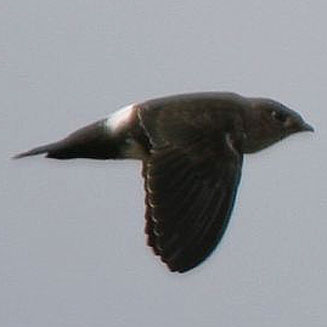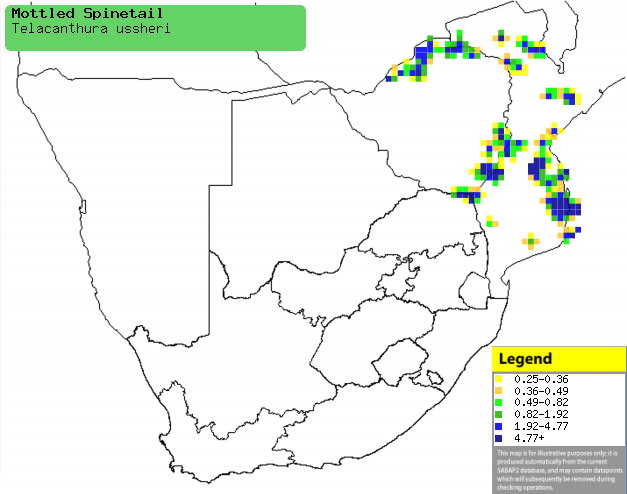|
Telacanthura
ussheri (Mottled spinetail)
Gevlekte stekelstert [Afrikaans]; Boabab-gierzwaluw
[Dutch]; Martinet d'Ussher [French]; Baobabsegler [German];
Rabo-espinhoso-malhado [Portuguese]
Life
> Eukaryotes >
Opisthokonta
> Metazoa (animals) >
Bilateria >
Deuterostomia > Chordata >
Craniata > Vertebrata (vertebrates) > Gnathostomata (jawed
vertebrates) > Teleostomi (teleost fish) > Osteichthyes (bony fish) > Class:
Sarcopterygii (lobe-finned
fish) > Stegocephalia (terrestrial
vertebrates) > Tetrapoda
(four-legged vertebrates) > Reptiliomorpha > Amniota >
Reptilia (reptiles) >
Romeriida > Diapsida > Archosauromorpha > Archosauria >
Dinosauria
(dinosaurs) > Saurischia > Theropoda (bipedal predatory dinosaurs) >
Coelurosauria > Maniraptora > Aves (birds) > Order: Apodiformes >
Family: Apodidae
 |
|
|
Mottled spinetail, Kruger National Park, South
Africa. [photo Trevor Hardaker ©] |
|
The Mottled spinetail is patchily distributed across
sub-Saharan Africa, and is most common along the West African coast. In southern
Africa it is scarce and localised, with scattered populations in Zimbabwe,
Mozambique and the Caprivi Strip. It mainly forages in small flocks, usually
over dense woodland, such as miombo (Brachystegia) woodland, evergreen and riverine forest, etc.
It usually lives in colonies of about 2-5 breeding pairs, however it does
occasionally nest solitarily. The nest is a half saucer, built of a wide variety
of materials glued together with saliva. It is almost always placed in a cavity
in a Baobab tree, however in other parts of Africa it also nests in buildings
and crevices.
Distribution and habitat
Patchily distributed across
sub-Saharan Africa, from Senegal to Kenya south to southern Africa. In southern
Africa it is scarce and localised, occurring in northern and south-eastern
Zimbabwe, Mozambique and north-eastern Limpopo Province. It mainly forages over dense woodland, such as miombo (Brachystegia) woodland,
or evergreen and riverine forest.
|
 |
|
Distribution of Mottled spinetail in southern Africa,
based on statistical smoothing of the records from first SA Bird Atlas
Project (©
Animal Demography unit, University of
Cape Town; smoothing by Birgit Erni and Francesca Little). Colours range
from dark blue (most common) through to yellow (least common).
See here for the latest distribution
from the SABAP2. |
Food
It usually forages in small flocks,
occasionally including other swift or swallow species. The following food items
have been recorded in its diet:
Breeding
- Usually breeds in colonies of about 2-5 breeding
pairs, however it does occasionally nest solitarily.
- The nest is a saucer-shaped bowl, built of a wide variety of
materials, such as feathers, twigs, bark and sand, all glued together with
saliva. It is almost invariably placed in a cavity in a Baobab (Adansonia digitata) tree, however in other parts of Africa it also nests in
buildings and crevices.
- Egg-laying season is mainly from November-March.
- It lays 1-2 eggs, which are incubated for unknown period.
Threats
Not threatened.
References
-
Hockey PAR, Dean WRJ and Ryan PG 2005. Roberts
- Birds of southern Africa, VIIth ed. The Trustees of the John Voelcker
Bird Book Fund, Cape Town.
|
